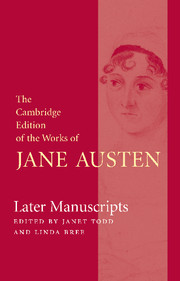Introduction
Published online by Cambridge University Press: 18 December 2020
Summary
Virginia Woolf famously claimed that Jane Austen was the most difficult author to catch ‘in the act of greatness’. If there are to be glimpses, some must come from the handwritten changes, elisions and revisions in the few prose manuscripts that survive: the small, closely written pages that form the unfinished works now entitled ‘The Watsons’ and ‘Sanditon’ and the cancelled chapters of Persuasion.
This volume of The Cambridge Edition of the Works of Jane Austen contains ‘The Watsons’, ‘Sanditon’, the novella ‘Lady Susan’, comments on fiction in a series of letters Austen wrote to her niece Anna Lefroy, the burlesque ‘Plan of a Novel’ and the comic letter to ‘Mrs. Hunter of Norwich’, as well as the opinions she collected on her own novels, Mansfield Park and Emma. It also prints poems, both serious, such as ‘To the Memory of Mrs. Lefroy’, written in 1808, and lightly frivolous, such as ‘On the Marriage of Mr. Gell of East Bourn to Miss Gill’, provoked simply by the oddity of names. An appendix includes works that have been ascribed to Jane Austen but for which there is insufficient certainty to warrant placing with the texts which are securely hers. The cancelled chapters of Persuasion, which would otherwise have found a place in the volume, have been included with Persuasion in this edition.
The novels published in Jane Austen's lifetime have for us now no private rehearsals – although two of them, Sense and Sensibility and Mansfield Park, received small revisions between published versions – and so the unfinished, fragmentary ‘The Watsons’ and ‘Sanditon’, frustrated attempts at finished works and meant in this state only for her own or her family's eyes, indicate habits of writing about which the published texts are secret. Their revisions, including the ‘scratching out’, may be placed beside the advice Jane Austen gave to Anna concerning descriptive minuteness, characterization, social verisimilitude and the paring down of detail when composing fiction.
The two fragments of ‘The Watsons’ and ‘Sanditon’ can of course only hint at the process behind the published works. They are equally secretive about how they themselves might have looked in their final state, though the comparison between them and the printed works clearly indicates the kind of changes that Austen's publishers made to her writing.
- Type
- Chapter
- Information
- Later Manuscripts , pp. xxxi - cxxxPublisher: Cambridge University PressPrint publication year: 2008



